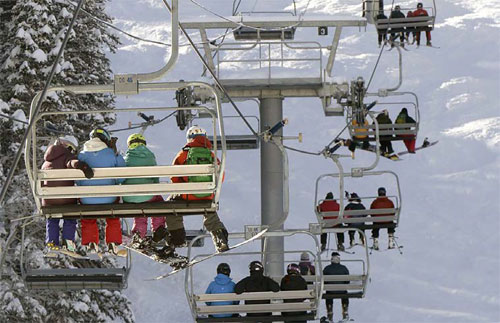By Brice Wallace
Not many industries, companies or individuals can describe the past 12 months or so “our best year yet.”
But that is the case with the Utah ski industry, which, despite the impacts of COVID-19, broke its record by having more than 5.3 million skier days during the 2020-21 season. That represents a 3.44 percent increase over the prior record of 5.13 million skier days during the 2018-19 season.
A “skier day” is defined as one person visiting a ski area for all or any part of a day or night for the purpose of skiing/snowboarding.
“Going into the season, our metric for success was simply getting open and remaining open,” said Nathan Rafferty, president of Ski Utah, the marketing firm owned and operated by the 15 ski resorts that make up the Utah Ski and Snowboard Association. “However, throughout the season, it became clear that skiing provided a respite from the day-to-day realities of the pandemic and allowed an option for guests to safely socialize outside.
“Our resorts came together to implement a variety of COVID protocols that allowed each of our resorts to not only remain open through the end of the season, but also break our existing Utah skier-day record. While 2020-21 looked different in terms of guest experience, it was our best year yet.”
For context, the 2012-13 had the lowest number of skier days during the past decade, with slightly more than 4 million.
The record was reached without breaking any single-day records and occurred as resorts instituted COVID-19 safety protocols, including capacity limitations and reservations for several mountains.
“While many of the resorts saw record-breaking seasonal numbers, most of Utah’s resorts did not see any individual day records broken,” Rafferty said. “With many skiers working remotely, it’s clear that guests were able to enjoy more off-peak skiing, like weekday afternoon visits or short lunchtime trips to the mountains. In addition, Utah benefits from a variety of multi-resort season passes that allow locals and visitors alike to spread out their skiing across all 15 resorts throughout the state, rather than flocking to only a few resorts.”
The industry was boosted by several snowstorms, including one in February that blanketed Little Cottonwood Canyon with more than eight feet of snow.
“We want to thank all of our resort operators and guests for doing their part to help keep Utah ski resorts open throughout the season and allow us to have another record-breaking year statewide,” Rafferty said.
Nationwide, skier visits totaled 59 million, making it the fifth-best season on record, according to the National Ski Areas Association.
“What a year it has been. From utter uncertainty to a top 10 season in terms of participation, it shows the wide spectrum that our industry bridged this year,” said Kelly Pawlak, the associatoin’s president and CEO.
“We are proud of the collaborative adoption of COVID-19 best practices that all ski areas implemented and diligently followed from opening to closing day. Americans yearned for safe outdoor recreation, and ski areas across the country delivered.”
Boosting the figures was that the average U.S. ski area was open for 112 days this past season, up from 99 days in the pandemic-shortened 2019-20 season.
Despite the challenges of the pandemic, 78 percent of U.S. ski area operators said this season exceeded their expectations.
“People had to change their habits during the pandemic, and ski areas were no different,” Pawlak said. “We tried new things and quickly learned that not only did they function as planned but many of these ‘work-arounds’ improved the experience for our guests and staff members. Ski area operators will use this experience to continue trying new techniques and technology.”
Capacity restrictions, remote work and school flexibility allowed for more skiers and riders to visit ski areas midweek. Weekday visitation during the past season accounted for 48 percent of total visits, up 27 percent from the prior season.








